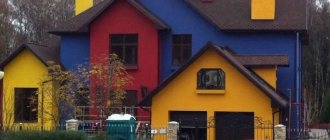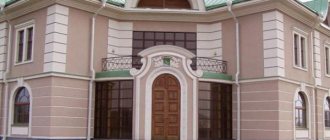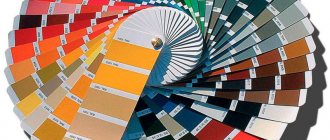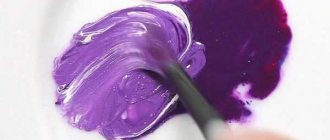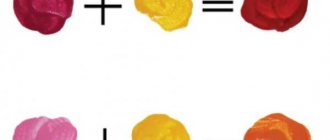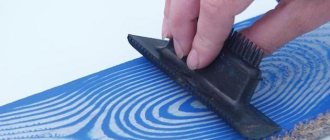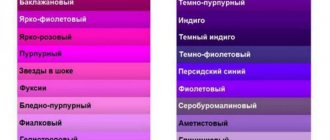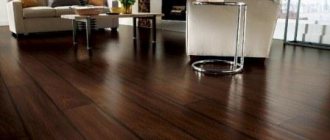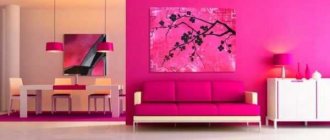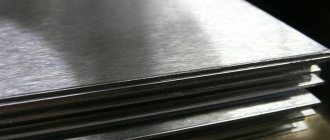If we talk about choosing facade paint, manufacturers produce it for different surfaces, different textures and shades.
There are coloring compounds that can be colored. The dye acquires the desired shade, which is chosen by the owners. The color scheme for façade paint is one color or several pigments are combined. In the second case, you can get a complex shade.
What determines paint consumption?
The most popular coloring composition is water-based.
It is affordable and has excellent technical characteristics; easy to use, and also harmless to human health and the environment. The scope of application of this composition is quite wide. After all, they can be used to paint surfaces made of any material. Water-based emulsion is suitable for painting walls both indoors and outdoors.
What will be the consumption of water-based paint per 1 m2 depends on many factors:
- The tool with which the coloring composition will be applied;
- Material of the surface to be painted;
- Surface condition and texture;
- Air temperature in the room where the work will be carried out;
- Type of material by component composition. So, acrylic composition has the lowest consumption, silicone takes second place, followed by silicate, polyvinyl acetate and latex.
Recommendations for choosing a shade for a facade
A house becomes beautiful and attractive if its facade is painted. The coating protects it from atmospheric agents. The coating acquires a rich shade. The paint itself is selected taking into account a number of house-building parameters:
- walls and roof should not be the same color;
- paint emphasizes the beauty of the material used to decorate the façade;
- architectural elements are drawn in 3-5 colors;
- the architecture of the surrounding area is also taken into account.
Dependence of consumption on the selected tool
How much coloring material will be used for painting directly depends on the tool with which we will paint the surfaces. The best option for applying it is to use a roller. They come in different types: for a smooth surface it is better to take a short-haired roller, and for embossed walls or textured finishes - a long-haired one. The longer the fibers of the tool, the more composition it will take.
Important: The most unsuitable option for water-based emulsion is a paint brush. It will waste a lot of paint. The best option to save material is to use a spray gun. With its help, we can regulate the pressure and flow of the water emulsion.
We paint different surfaces
The consumption of water-based paint per 1 m2 of wall largely depends on the material of the surface that we will paint. So, when applying the composition to wallpaper, there will be a large consumption, since the paper absorbs the water-based emulsion well.
For painting on plaster, material costs will be different. It all depends on the texture of the surface. If the coating is smooth and even, then less coloring agent will be used. But for processing, for example, fur coat or bark beetle, which have a very porous surface, more material will be consumed. But waterproof coatings will absorb less.
Advice: A surface made of polystyrene foam or wood, gypsum boards will absorb more of the paint composition due to their loose structure, but for painting metal or concrete with a denser surface, the costs will be lower.
To paint a facade, the cost of painting material will be much higher than when working indoors. Due to the air, wind and humidity outside, the paint dries quickly, so uneven coverage is possible. And this requires an additional layer to be applied to the facade walls.
Material cost calculator
Thus, GOST indicates that the nominal consumption of water-based emulsion is 100-150 ml for one layer. But this figure may vary depending on the type of surface and type of composition.
If the paint needs to be tinted, then you need to purchase the desired dye by choosing from the color palette. In order not to overpay in the store, you can calculate the material costs yourself. The color consumption per 1 kg of water-based paint is 30 ml per 1 liter of paint.
The consumption rate of water-based paint per 1 m2 is in the table:
| Type of paint | Paint consumption per 1m2 in one layer, kg | Paint consumption per 1m2 in two layers, kg |
| Latex | 0,6 | 0,4 |
| Polyvinyl acetate | 0,55 | 0,35 |
| Tex water soluble | 0,6 | 0,4 |
| Veak-1180 | 0,150 | 0,12 |
| Glass wallpaper | 0,05 | 0,03 |
Water emulsion cost calculator for interior work:
The material cost figure is always indicated on the packaging. But as confirmed by the pros, they do not always correspond to the costs in practice. Therefore, this point should also be taken into account.
How to save coloring agent?
To save coloring material, you must follow some rules when applying paint. Before you start painting, the walls must be coated with a primer or other compositions of a similar effect. The primer will create a coating on the surface that will reduce material consumption and at the same time help improve adhesion between them.
Another trick to save material is to add more water or PVA glue to the mixture. Thus, the volume of the composition will increase and it will be enough to cover a larger surface area. Usually, when painting, two layers of paint are enough. At the same time, they should be thin, with the second layer being smaller than the previous one.
We study and use the tinting table: color for water-based paint for walls
The tone of the painting material offered by the manufacturer does not always satisfy the consumer.
To give the desired shade to the composition, water-based paint color is added to its base.
… VKontakte Facebook Twitter Google+ My world Contents:
- What are colors
- Types of colors, how to choose, how to dilute and how to choose a color
- Sequence of tinting
- Features of the use of colors
- Useful video: mixing color with paint
Adviсe
The following are general tips for mixing paints:
- To select a particular tone, use a paint tinting table indicating the mixing ratio.
- After choosing a paint shade from the table, you should check that it was made by the same manufacturer, ideally, make sure that the pigment and base are from the same brand.
- A base of the same color may contain a different number of binders, which determines the quality of the paint and varnish material. This indicator is definitely worth comparing, and even more so if you plan to color the paint in dark shades.
- When choosing a pigment, you should give preference to pigments in bottles with a narrow neck. This makes it possible to dose the addition of color to the paintwork material.
- When mixing manually, it is best to make a small reserve, approximately 20% of the calculated volume. The remainder of the paintwork should be tightly sealed in a jar and stored in case of cosmetic repairs.
You can do the coloring yourself, but the most important thing is to act slowly, add color gradually and mix the paintwork evenly.
What are colors
A color is a concentrated pigment based on a binder or a paste-like consistency saturated with one of the colors. The main purpose is to give existing paints the desired shades.
Coloring pastes are used for all surfaces. Before painting them, each owner is puzzled by choosing the right color so that the latter simultaneously matches the interior. Retail tones do not always meet consumer needs, and choosing the right one can be difficult.
Why do you need a paint color? White color is usually taken as a basis, and in order for it to acquire the intended shade, concentrated pigment is added to it. Mixing the color with the coloring base is carried out in the following quantities:
- no more than 20% for water-based paints;
- no more than 1.5% for oil-based paints;
- no more than 7% for other types of paints.
Such decisions were made due to the high saturation of color schemes. With a high concentration of color, the performance of the paint is reduced.
Compositions
There are several types of tinted substance.
- Paint (this composition must fully correspond to the paint and varnish material used).
- Paste (implies ease of use, allowing you to adjust the shade when mixing).
- Dry composition (the most affordable, the only disadvantage is the limited range of colors).
To create, dilute and obtain the correct tone for uniform coloring of the plane, you need to take tinting paint. This type of paint is created by mixing the main base shades with a coloring element - color.
There are 6 basic colors:
- blue;
- green;
- black;
- red;
- yellow;
- white.
Types of colors, how to choose, how to dilute and how to choose a color
Color is added to the paint to give it a color that matches the style of the room.
Types of pastes are divided into:
- inorganic;
- organic.
The second ones on the list have bright tones. At the same time, the choice of color palette is quite large. But, despite this advantage, there is one drawback - they quickly fade when exposed to sunlight.
Inorganic pigments are produced in limited quantities; their colors are dull, but they retain their color properties for a long time.
How to choose a color for painting walls? To do this you need to do the following:
- Explore the proposed catalog.
- In the absence of a color code, it is not necessary to experiment with obtaining a tone in a store, since the color obtained in this way will differ from the one created in everyday conditions.
- The color must be mixed with a small portion of the color base.
- When lighting a room artificially, it is recommended to use organic pigments, and when natural color predominates, inorganic ones.
- The products of a foreign manufacturer are not necessarily better than domestic ones. Russian manufacturers produce tinting pastes of no less quality than the products of their foreign colleagues.
- You should pay attention to the neck of the bottle, it should be narrow, this will make dosing easier.
- A palette of water-based paints will not be superfluous when purchasing diluted pigment, it will be easier to navigate in order to get the expected shade.
What are the different paint colors from modern manufacturers? Well-known brands of tinting pastes include:
- Tikkririla. The products of this company are designed to obtain the expected result after initial dilution with the base. In total there are more than 2000 tones from this manufacturer. The manufacturer offers a choice of a number of shades for painting facades.
- Natural Color System (NCS) - the color is made according to the standards of Swedish and Norwegian manufacturers. There are only 6 primary colors in the range: yellow, black, red, green, blue and white. Other tones are derivatives of them. Based on the letters and numbers printed on the containers, it is easy to decide on the choice of color.
- Tex is a company that produces pastes based on pigments produced outside the Russian Federation. They are versatile and are used to add color to water-based paints, putties and added to whitewash. Used for interior work and painting facades.
- Rogneda is a network of Moscow organizations that produces products for artistic purposes and adding tone to paint, plaster or putty. The color of this company is resistant to exposure to the sun and negative temperatures, and also has high adhesion properties.
- Elakr is a color for façade paint. It is resistant to negative environmental factors and resistant to light. Ideally stored at sub-zero temperatures. Most façade paints are produced on a white base and require diluting to give them color.
Is the color white or not? Basically, the manufacturer produces colored pastes in light and rich colors, but in some cases there is also a white color. It is typically used to provide weather resistance and abrasion protection for advertising lettering and graphics.
Important! Products for water-based paints have gained the greatest popularity, but for other types of paint bases it is not difficult to purchase the appropriate pigment.
The effect of the supplement on human health
Food coloring E150 is approved for use in all countries of the world. There are no strict prohibitions or restrictions in this regard, however, in the USA there is a requirement regarding the E150d subtype - its presence in the product must be indicated.
Scientists currently do not have any confirmed data regarding the benefits of consuming sugar coloring. And the popularity and widespread use of the substance is due to its almost complete harmlessness to the human body. The possible harm from it is the same as from regular sugar - it can provoke allergic reactions and is contraindicated for diabetics. For people who are overweight and have problems with the gastrointestinal tract, it is better to limit the consumption of caramel and products containing it. The danger in the composition of the additive may be rather residual traces of acids, alkalis and salts.
There is information that the E150d dye variety is a carcinogen, and in certain quantities provokes the appearance of malignant tumors, but science has no official confirmation of this data.
The food additive “sugar color” is perhaps one of the most ancient dyes and sweeteners known to man. From the very moment sugar began to be produced, people began to study its properties and tried to heat it, eventually obtaining caramel. A simple and inexpensive substance of natural origin could not go unnoticed by food manufacturers. Already in the 19th century, when food began to be produced in factories, the dye “sugar color” began to be used first in confectionery, later in drinks and other foods.
Since this substance does not pose any significant harm to humans, it can be consumed in limited quantities by children and adults, with some exceptions for health reasons.
Sequence of tinting
How to tint paint at home so that the color matches what you expect? First you need to calculate the amount of material needed to perform painting work in a given room.
If there is not enough paint to complete the work, it is unlikely that the same proportion will be maintained again. How to dilute color in water-based paint?
Stages of obtaining color:
- Pour a small amount of white paint into a small container.
- Then the color is added to the white base little by little, and it is important to record how much coloring matter was added. In this way, the expected shade is achieved. The main thing is to remember how much color was used.
- It is recommended to add the coloring mixture in drops using a syringe with the needle removed. This will make it easier to follow the dosage.
- After obtaining the desired tone, the surface is painted. This is necessary to ensure that the color meets the requirements. Moreover, it is enough to paint an area of no more than 0.5 m2.
- If everything is fine, then you can thin the paint and safely paint the walls. If an unsatisfactory result is obtained, experiment any number of times.
To get a rich color, the color should be added to the paint before painting operations, but no later than 2 hours before starting work. If the time period is increased, the pigments will settle to the bottom and the painted surface will not be as bright as expected.
Important! Wall surface colors are checked for consistency using lighting fixtures. Surface mixing of the color is not suitable; it should be mixed thoroughly, preferably with a mixer. The preparation of the paint composition should be done in one container.
Instructions for self-tinting
Once the choice is made, you can get to work:
Stock up on small glass jars or plastic food containers in advance. Before use, you must wash them thoroughly. This is very important when tinting; Pour the paint into the prepared jar, be sure to write down its volume. This will be useful for further mixing. Add a few drops of color to it. If you decide to make a complex color, add two different colors
Start with one to three drops and add carefully drop by drop until you get the color you want. Record the number of drops added; To obtain a uniform color, mix the solution well; Having received a suitable color, you can paint a small section of the wall and check the color after a day, when the paint has dried completely
If you like the shade, then tint the remaining paint, observing the required proportions; If the shade does not suit you, you can increase or decrease the amount of color or add another one. Without experience, it is difficult to choose the right color, but perhaps for this you need to be patient and take your time.
Features of the use of colors
Kohler means tone or color (this is a translation from Latin). Depending on the dosage of the added material, the desired shade can be achieved. It is used for painting interior and exterior substrates.
Designed for painting:
- wood surfaces;
- concrete;
- bricks;
- plasters;
- drywall;
- metal
Suitable for paints based on water-based compositions, oil-based and alkyd, epoxy compositions, nitrocellulose and polyurethane foam.
The color chart is specially designed to facilitate the selection of colors. It indicates the proportions of paint and color.
For example, 1:5 means that the color consumption for five parts of the main color is one part. There is no need to add a large amount of material at the same time, since the paint base can be ruined.
To properly perform dilution, you must adhere to the requirements set out in the instructions developed by the manufacturer. The measurements must be the same volume. It is important to know that it is better to purchase paint and color from the same manufacturer.
Is it possible to paint with color? This is a question some people ask. The color is specially designed to impart tonality to the main color; it is rich in pigment. Therefore, its basis is a binder. The adhesion between the surface and the base will be the same as when painting with regular paint. So the color itself can be used for painting work, but it will be quite expensive.
Advice! If the concentrated pigment is not used in full, then the remaining material can be mixed with water. Thus, it will be preserved for at least 5 years.
Preparing water for entering the palette
Since the use of water-based paints, many experiments have been carried out to improve its application. Craftsmen introduced various chemical solvents into the paint to dilute it. Thus, wanting to improve the properties of the coloring mixture.
But in most cases this led to the latter simply collapsing. Lumps formed in it, which subsequently completely refused to dissolve. And the composition lost all the necessary properties. Therefore, experts unconditionally say that the only correct solution is to use water. Because it acts as the basis of the palette.
Distilled water for diluting paintSource arteziano.ru
But before diluting water-based paint, you need to make sure that the liquid meets the required parameters
First of all, pay attention to the ambient temperature. Because the coloring composition tends to thicken faster at low degrees, and literally turn into water in high heat.
Therefore, during interior work, it is always checked that the water is at room temperature. This will prevent a lot of unnecessary problems. But outside it is recommended to use slightly heated water. This technique will slow down the thickening of the composition, which occurs faster in the open air. True, the method should only be used in cold weather.
Heating water for diluting paintSource proctologi.com
The second serious factor that can impair the quality of painting is the presence of impurities. After all, water perfectly dissolves everything that is introduced into it. And if not completely, then it is still enriched by the elements that got into it.
And this will have a detrimental effect on the characteristics of the palette. Its color may change or the necessary properties may decrease. Therefore, the best way out would be to use distilled water. There is no need to prepare it yourself by running it through a homemade apparatus. It is sold in all auto stores and most hardware stores.
But you can still remove all unwanted impurities from ordinary water at home. To do this, just boil it and let it settle. At the same time, it reaches the desired room temperature on its own. After this, you just need to carefully pour it into another container so that all the sediment remains in the original container.
Preparing water for diluting paintSource legkovmeste.ru
Color Mixing Chart
- Articles, repairs, instructions
The choice of paint today is good, but if you need a rare shade that is not on sale, you will have to mix several tones. We offer a color mixing table, which indicates which tones and in what proportion should be mixed to obtain the original shade.
Some tips:
- — The color of the paint manufacturer does not always correspond to the classic one, so the proportions may vary slightly,
- — Keep in mind that acrylic paint darkens when drying, as water evaporates and increases the concentration of pigment,
- — Do not spread all the paint at once - do a test spread,
- — The best mixing option is to use a mixer (attachment to a drill).
| Visual display | Color name | Mix to get it |
| Pink | 90% white + 10% red | |
| Royal red | 5-10% blue is added to red | |
| Tomato red | Add 5% brown and yellow to red | |
| Crimson | Blue base + a little white, brown and red in equal proportions | |
| Chestnut | Add 5% brown and 3% black to red | |
| Red | If you want to lighten red, add white | |
| Orange | Add up to 30% red to yellow | |
| Yellow | Yellow - lighten with white, darken with red and brown | |
| Olive | Green base + 10-20% yellow | |
| Turquoise green | Add up to 25% blue to green | |
| Bottle green | Yellow + 20-40% blue | |
| Turquoise blue | In blue 10-15% green | |
| Royal blue | In blue 10-15% black and 2% green | |
| Dark blue | Blue + 5% black and 2% green | |
| Grey | In white to 5% black | |
| Medium brown | Add red and blue to yellow in equal portions, add white if you want to lighten it, darken it with black. | |
| Golden brown | To yellow we add 10% blue, white and red, the more yellow, the higher the contrast. | |
| Mustard | In yellow, 5% black and red + 1-2% green | |
| Beige | Add white to brown while stirring until the desired tone is obtained, add yellow for brightness | |
| Pink gray | In white up to 5% black or red | |
| Gray-blue | In white up to 5% light gray + 1% blue | |
| Green-gray | In white 5% light gray + 1% green | |
| Gray coal | Black is added to white until the desired tone is achieved (with constant stirring) | |
| Lemon yellow | In yellow 5% white and 1-2% green | |
| Fern green color | Add black, green and white paint in equal parts to white | |
| Forest green color | Green is diluted with black (up to 5%) | |
| Emerald green | Yellow diluted with white (less) and green (more) paint | |
| Light green | Yellow is diluted with white (5%) and green (10%) paint | |
| Aquamarine | Add up to 35% green and 5% black to white paint | |
| Avocado | Add black and brown paint to yellow in equal parts (up to 10%) | |
| Royal purple | Red color is diluted with yellow and blue paint | |
| Dark purple | We dilute the red tone with black and blue paint | |
| Mandarin, orange | In yellow paint up to 10% red and up to 5% brown | |
| Reddish chestnut | Red is diluted with black and brown | |
| Orange | White diluted with red and brown | |
| Burgundy red color | Add 5-10% yellow, brown and black paint to red paint in equal parts | |
| Plum | In red, 10% black and blue and 5% white | |
| Chestnut | Add white, red and black paint to yellow in equal proportions | |
| Dark brown | In yellow paint 10-20% each of red, white and black | |
| Black | Black is lightened to different shades of gray with white |
What is paint color?
The word “kohler” is translated from the Latin “color” as color or tone. In the chemical industry, color is a special highly concentrated pigment composition with which you can obtain almost any shade of paint. Moreover, not only water-based products, but also façade, oil, and acrylic products can act as a base. Depending on the concentration of such pigment composition in the paint, you can achieve both rich and bright colors and muted, pastel shades.
What is it needed for
The use of color helps property owners turn almost any design idea into reality. The process of mixing and diluting paint and varnish material with pigment is called tinting. Its use is suitable not only for finishing work inside the building, but also outside it. Using a special pigment solution, you can obtain unique shades, for example, the paint can be given a copper, pearlescent, bronze, or golden hue.
The color can be used on concrete, brick, plastered walls. Other surfaces can also be treated with compositions using it: plasterboard, wood, fiberboard, chipboard. The use of tinting is necessary in the following cases:
- the original layer has minor defects;
- you need to choose a shade in accordance with the color scheme of the interior;
- you need to decorate the interior using several shades of one or more colors;
- you need to correct errors that occurred when calculating the volume of paint or the absence of a color used previously.
Kinds
When planning to buy a color for water-based, acrylic or any other paint, familiarize yourself with the types of these products. You can order it in a specialized online store with delivery by mail. According to the range of applications, it can be universal, i.e. compatible with any paint and varnish materials, and highly specialized. Colorants are produced in the form of paint, dry composition, paste. The latter option is more convenient to use, but there is a possibility that the intensity of the finished paint will be uneven. Based on their composition, the following colors are distinguished:
- With organic pigments. Products of this type are distinguished by a more saturated range of colors, but the paints and varnishes obtained from them lose their brightness and saturation over time due to exposure to sunlight. For this reason, compositions with pigments of organic origin are considered not the best choice for facade paints.
- With inorganic pigments. Such products are more resistant to aggressive external factors, including burnout. True, this paint color cannot boast a wide range of shades.
Rules for tinting
You can tint the paint manually or computer-aided. Thanks to the first option, you can save a significant amount of money and perform the procedure directly at the repair site. There is also a drawback: it is almost impossible to reproduce exactly the same tone again. The second type of tinting is controlled through a special program. The operator only needs to select the color scheme, and the program itself will determine the proportions, after which it will produce the finished composition.
When deciding to dilute the pigment yourself, consider the technique:
- Decide on the required amount of color. It is better to initially buy more than to look for identical products later.
- It is recommended to select a color for painting surfaces by making a sample. To do this, fill a small container with 100 mg of white paint and add a few drops of pigment to it. By mixing, obtain the desired shade.
- Check how the resulting composition looks on the wall or other surface that needs to be painted. The color of the finished solution does not always match the shade of the paint and varnish material applied to the wall. The result should be viewed under the lighting prevailing in the room (artificial or natural), after the composition has dried.
- If you know how many drops you had to add to get the desired color, then by recalculating the consumption of the composition per liter of paint, you can dilute and get the required amount of color.
- The pigment composition should be added to the paint and varnish material in a thin stream. At the same time, do not forget to mix everything thoroughly to obtain a concentrated composition with a uniform color.
Work order
Manual and computer tinting have a number of distinctive features. And if with the latter it is not necessary to go into details, because... The service will do everything for you, but it’s still worth understanding the rules and procedure for manual tinting if you don’t want to ruin the material and waste valuable time.
DIY paint tinting
For manual tinting:
Prepare large, clean containers for mixing the ingredients. Calculate the required volume of color using a map or color table (each manufacturer has its own). If desired, you can make your own individual color
In this case, it is especially important to fix the proportions of the color and base in order to, if necessary, reproduce a similar tone. Place a white base in a bucket and add one or more color components (it is better to take 20% less than the norm and gradually add color). First mix the composition by hand, then take a drill with a zigzag mixing attachment and mix the paint until it has a uniform consistency. Remember or write down the exact ratio of ingredients used
It is better to immediately prepare enough material for the entire scope of work. Since it will be impossible to obtain an identical composition. Apply paint to part of the surface. Keep in mind that fresh paint will look darker than dry paint. And the color of the coating on a large area is lighter than on a small one. There is also a difference in the perception of color under natural and electric lighting. If you are satisfied with the test result, proceed to painting the rest of the surface.
Video: how to tint paint yourself
Computer tinting
For automatic mixing:
- Select a paint color from the catalog and enter its number into the calibration machine program.
- The program calculates the component composition of the coating. One or more colors are automatically added to the base paint.
- The material is thoroughly mixed until smooth.
In this way you can create more than 10 thousand shades. Colors can be added to all types of paints, varnishes, impregnations, enamels, etc. Their properties do not change when adding color components.
How to choose a paint color
To begin with, depending on your goals, choose between organic and inorganic products, taking into account the features of each option. Then decide on the state of the color: liquid composition, paste or loose pigment:
- The first option contains the same components as in the paint and varnish material (paint and varnish material): if you are going to use water-based paint, then the color composition should be the same.
- Bulk pigment is inexpensive, but it has a limited palette.
- The most convenient option is color paste.
Choose the right color:
- You can choose a shade using the catalog - it is available in every specialized store. Please note that the shade looks different depending on the lighting.
- If the room where you want to paint the walls is light, then give preference to a synthetic pigment. Under artificial lighting, colors that contain organic substances look great.
- The color scheme of the surface should be in harmony with the background of the flooring and furniture. If the floor is made in a green-blue shade, then it is better to decorate the walls in a golden or yellowish tone. If the floor surface is brown, it is better to make the wall color beige.
- The range of wall coverings can be rich and bright: it is known that rich shades can lift the mood. These include lush green, golden, brown or ocher tones. Please note that blue shades in evening light appear more faded than in daylight.
- Please note the manufacturer. Well-known suppliers of colors are Caparol, Monicolor Nova, Colorex, Izhsintez, Decorazza, Unisistem, Olki, etc.
For water-based paint
If you are looking for a high-quality color for water-based paint, then pay attention to the universal dye “Profilux PROFICOLOR No. 18 blue. Can be used for cement plasters, oil-based paints and varnishes. At the same time, it is cheaper than many other pigment compositions - only 30 rubles apiece. The composition is environmentally friendly, water based:
- name: Profilux PROFICOLOR;
- price: 30 rub.;
- characteristics: country of origin – Russia, volume – 0.13 l, colors – blue, caramel, brown, black, coffee, etc.;
- pros: reasonable price, low consumption, large selection of colors;
- cons: none.
Another excellent universal dye option is Dufa D 230. This high-quality diversified dye is made on the basis of synthetic resins. Intended for decorative design of interior and façade surfaces. Water is used as a solvent:
- name: Dufa D 230;
- price: 365 rub.;
- characteristics: volume – 0.75 l, colors – red, wood brown, yellow, orange, green apple, etc., consumption rate – 0.15-0.20 l/m2, gloss level – deeply matte, density – 1 .3 kg/l, application temperature – from +5 degrees, shelf life – 5 years;
- pluses: large palette of colors, high quality, light fastness, resistance to abrasion, lime;
- cons: costs more than analogues.
For tinting water-dispersion paints and decorative plasters, products from Tury Scandinavia Classic are a good option. Suitable for paintwork materials that are used both inside and outside the object:
- name: Tury Scandinavia Classic;
- price: 206 rub.;
- characteristics: packaging – 1 kg, drying time – about 1 hour, colors – mint, salad, green, lemon, red-brown, pink, beige, etc.;
- pros: low cost, large range of rich and bright colors;
- cons: large packaging.
For acrylic
If you are looking for a suitable color for acrylic paint, then PalIzh products may suit you. This pigment composition is recommended to be used not only for tinting acrylic paints and varnishes without limiting the percentage of input, but also for painting and painting small surfaces: concrete, wood, brick, stucco, canvas, etc. More details about the product:
- name: PalIzh;
- price: 211 rub.;
- characteristics: weight – 0.25 kg, drying time – 1 hour, consumption per 1 layer – 150 g/m2, colors – pink, blue, metallic purple, metallic emerald, etc., shelf life – 5 years;
- pros: quality, original colors;
- cons: high cost.
Another good choice would be the universal PalIzh Standard product, used for tinting paintwork materials, wood glazes, plasters and grouts on organic and water-dispersion bases. The product is compatible with paints from any manufacturer. It retains its consistency and properties during several freezing cycles:
- name: PalIzh Standard;
- price: 52 rub.;
- characteristics: volume – 0.1 l, shelf life – 5 years, colors – graphite, gold and silver veneer, sunny, fuchsia, coral, scarlet, dark red, etc.;
- pros: high versatility, saturation, brightness;
- cons: costs more than analogues.
For facade paint
Products from the Faydal brand are perfect for tinting façade paintwork materials. Its pigments are highly resistant to UV radiation, and the color itself is available in 19 bright and rich shades. This product is also suitable for tinting interior paints, putties and water-based plaster mixtures. It can be used for application indoors on mineral surfaces such as brick, concrete, drywall, glass wallpaper, and any type of putty:
- title: FEIDAL VOLLTON – und Abtönfarbe;
- price: 468 RUR;
- characteristics: volume – 0.75 l, specific gravity – 1.4 kg/l, gloss – deeply matte, composition – acrylic dispersion, fillers, pigments, functional additives, water, colors – chocolate, umber, apricot, etc.;
- pluses: resistance to ultraviolet radiation, high covering power, original shades;
- cons: bulk packaging.
Another good color for facade paint is JOBI. The product is suitable for the decorative design of facade and interior elements, tinting water-based paints and varnishes, plasters and enamels. Can be used in its pure form for stenciling and artistic work:
- name: JOBI;
- price: 182 rub.;
- characteristics: volume – 0.5 l, weight – 0.7 kg, colors – apricot, anthracinte, burgundy, yellow, green, etc.
- advantages: light and weather resistance, high air and vapor permeability, reasonable cost;
- cons: none.
For oil paint
Aqua-Color Unicolor is a universal acrylic tinting paste, ideal for finishing the facades of buildings and country houses. This color is available in a wide range of colors and has excellent compatibility with alkyd-oil and water-based materials. They can even tint grout and cement mortars. It is used for repairing offices, apartments, building facades, and cottages. Ideal for oil paints:
- name: Aqua-Color Unicolor;
- price: 50 rub.;
- characteristics: volume – 100 ml, consumption – 100 ml/20 kg paintwork materials, colors – lemon, yellow, light ocher, dark, red-orange, etc.;
- advantages: light fastness, low consumption, convenient packaging;
- cons: none.
If you are looking for a relatively inexpensive color for oil paint, then pay attention to the universal products from Krafor. The use of this paste is possible even for non-traditional materials, but a preliminary test must be done. Suitable for external and internal work:
- name: Krafor;
- price: 31 rub.;
- characteristics: volume – 100 ml, shelf life – 36 months, composition – pigment, polyhydric alcohol, special additives;
- advantages: high coloring power, light fastness, wide color gamut;
- cons: minimum quantity of 6 pieces.
Video
Popular posts
- Chair for dressing table Chairs for dressing tables in Moscow - 189 Products Company from Moscow, delivery 29643 a In…
- Silicone sanitary sealant Silicone sanitary sealant white in Moscow - 1491 products Company from Moscow, delivery (tomorrow) 140...
- Shelf in the hallway Currently, there are a huge number of different options for shelves in the hallway, and this is directly ...
- Insulation of the floor in a wooden Insulation of the floor in a wooden house from below: materials and installation technology SHARE ON SOCIAL NETWORKS One of the common…
